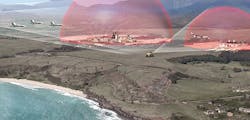Laser navigation for unmanned aircraft in RF- and GPS-denied areas developed by ADSYS
ATLANTA, 7 May 2015. U.S. Navy shipboard unmanned aviation experts needed navigation and landing capability for unmanned aerial vehicles (UAVs) in areas where RF and GPS signals are jammed or disrupted. They found their solution from ADSYS Controls Inc. in Irvine, Calif.
ADSYS is working with the Naval Air Systems Command at Patuxent River Naval Air Station, Md., to develop the Laser-Aided Recovery System (LARS) for precision 3D navigation and landing capability for ships and land sites where RF jamming is in effect.
ADSYS is working under terms of a Small Business Innovative Research (SBIR) phase-two agreement with Naval Air Systems Command on current LARS development, says James Garrett, director of business development for ADSYS.
The company is showing the LARS laser navigation system this week to substantial interest at the Association of Unmanned Vehicle Systems International (AUVSI) 2015 conference and trade show in Atlanta.
Related: Northrop Grumman, Lockheed Martin to develop pod-mounted aircraft and UAV laser defenses
The LARS airborne receiver offers low size, weight, and power consumption (SWaP), which makes it suitable for placement on manned and unmanned fixed-wing aircraft and helicopters.
It uses eye-safe lasers to broadcast navigation signals to several aircraft at the same time. The system's eye-safe laser helps it resist electronic jamming, and helps the system operate stealthily with low probability of intercept in hostile conditions.
The LARS laser communications uplink allows for system reconfiguration, vehicle deconfliction, and flexible user-vehicle command for system updates or to adapt to changing conditions.
LARS has two primary subsystems: the LARS Reference Station, and the LARS Navigation Unit. The reference station has eye-safe lasers, on-the-fly reconfigurability, offers low SWaP, and can be placed on the ground, aboard ships, and aboard aircraft.
The LARS Navigation Unit, meanwhile, is weatherproof and rugged, can interface with aircraft flight-control computers, weighs one pound, measures 15 cubic inches, and consumes 5 Watts of power. It can be placed aboard fixed-wing aircraft and helicopters in manned or unmanned configurations.
LARS has an operation range of as far as 62 miles during the day, at night, and in bad weather. It operates independently of any RF signals, and can help expand unmanned aerial vehicle operations while reducing operational costs, company officials say.
For more information contact ADSYS Controls online at www.adsyscontrols.com, or Naval Air Systems Command at www.navair.navy.mil.

